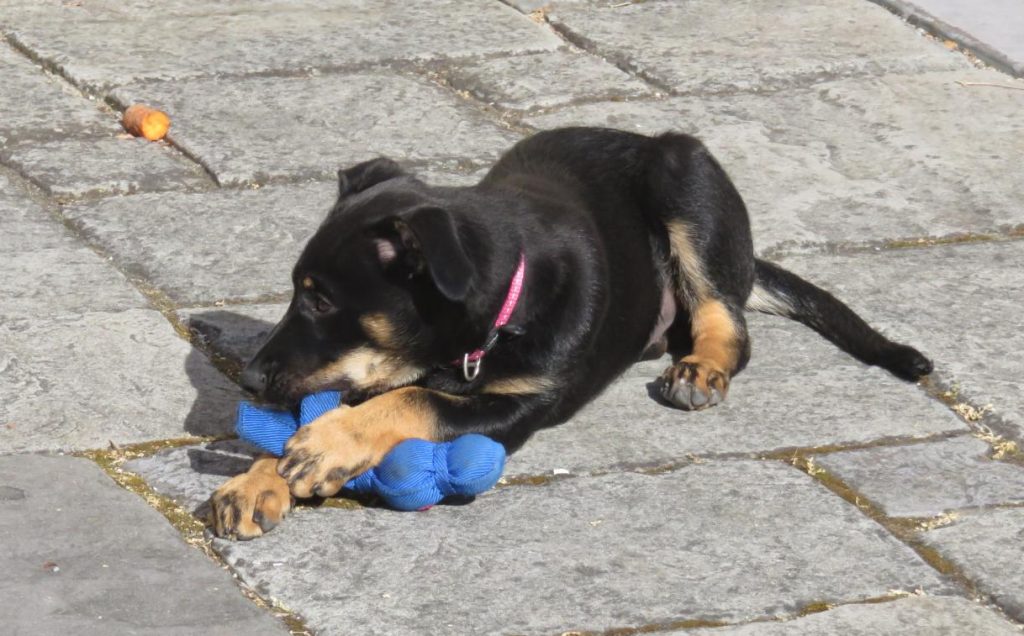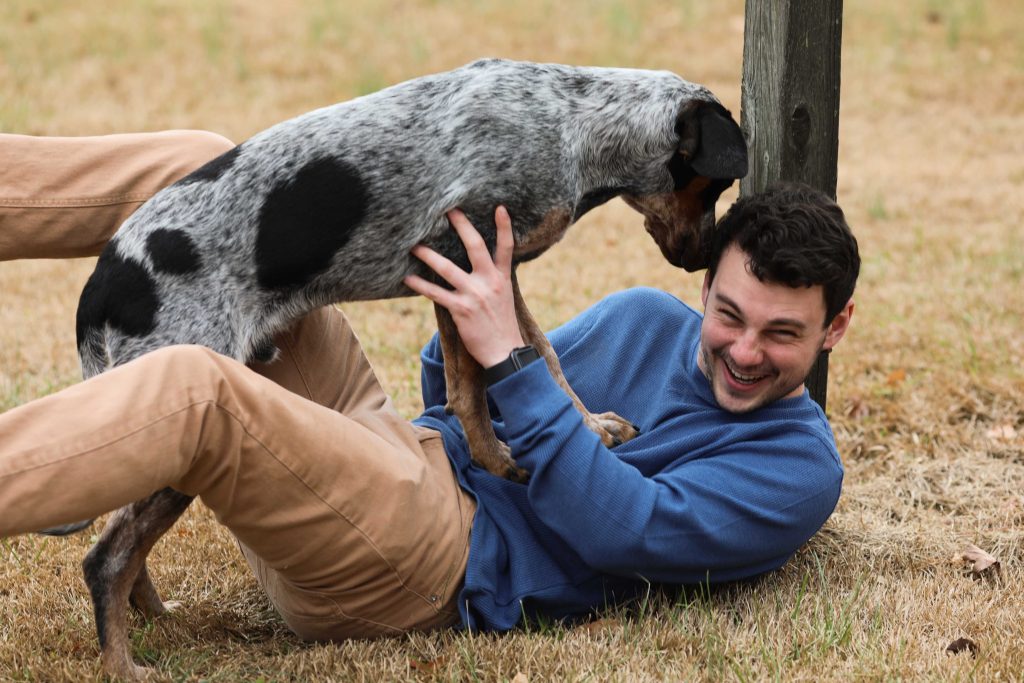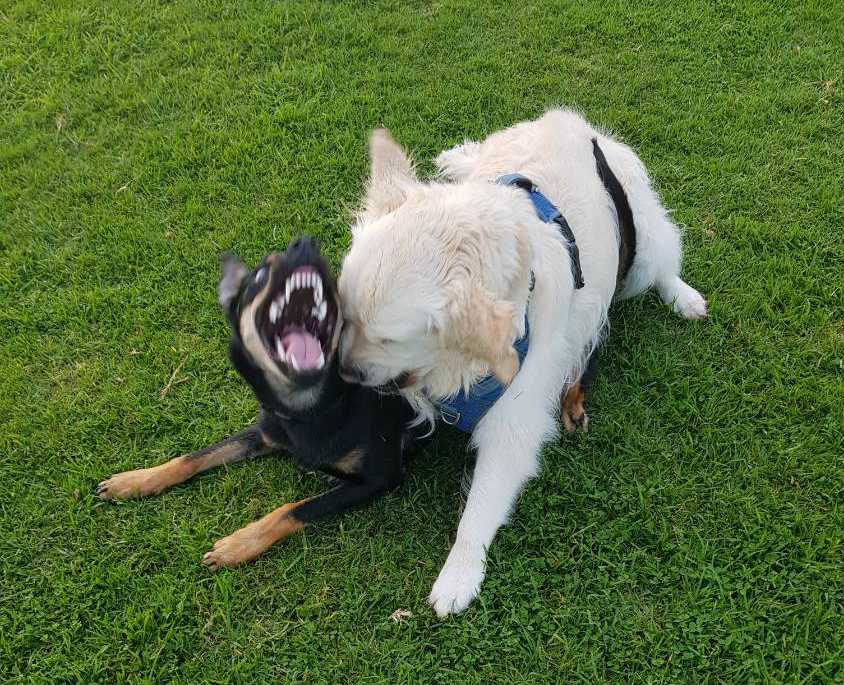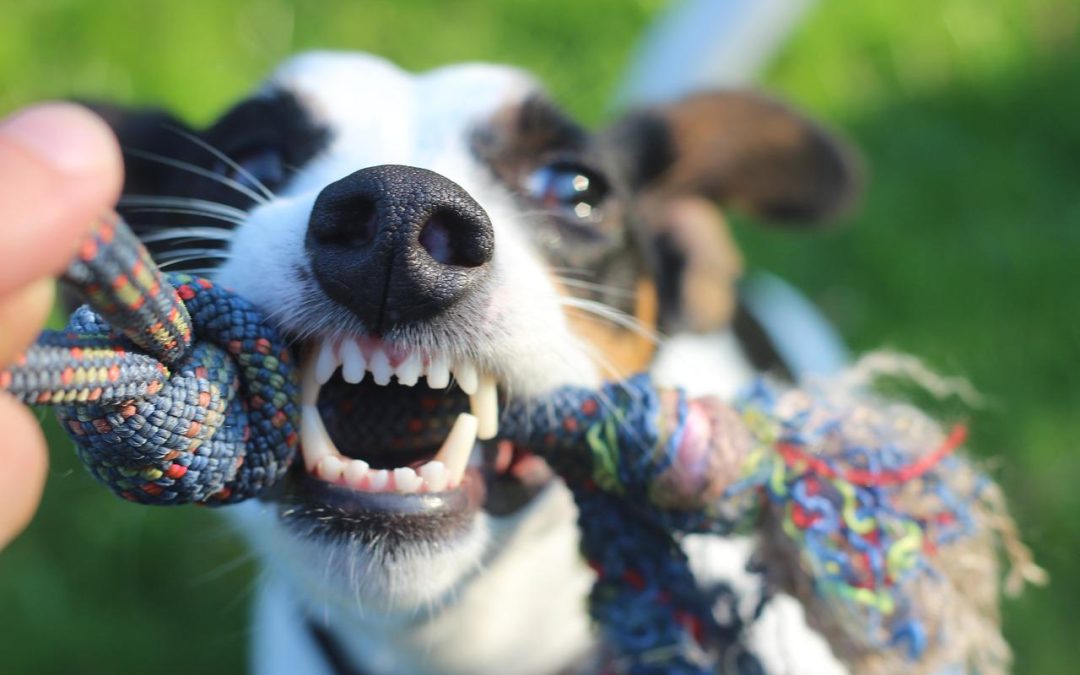If you’re anything like me, there’s nothing worse than getting sharp little needle teeth all over you when all you want is to have a lovely play session with your gorgeous new puppy.
Your puppy seems to just looove to latch onto your clothes, shoes and skin, rather than onto the toy you are offering them.
Why is your puppy seemingly so deliberately mean? And how can it be stopped so that you can enjoy playing with your puppy without feeling at risk all the time?
First of all, we need to understand WHY puppies bite!

Believe it or not, biting is a totally normal and necessary part of puppy development. They bite a lot so they can learn how to bite.
“But I don’t want my dog to learn how to bite!” you might be thinking in panic.
Let me explain it this way… Your puppy doesn’t have hands to use for picking up and grasping objects. Their only grasp mechanism is bite!
Also, think what you do if you’re in an emergency. If you were standing on a bridge, happily leaning on the railing and that railing suddenly gave way, what would you do? Grab for something! You use your hands to save yourself. A dog can’t do that. So their only reaction is to use their mouth. They have no other way to grab.
So we’ve established that your puppy needs to bite!
That means that it’s important to teach your puppy HOW to bite appropriately…to INHIBIT their bite.
In an emergency you want your dog to use their mouth safely, without harming anyone.
Many puppies grow up in large litters where they begin practising bite inhibition with fellow litter mates right from 3-4 weeks when they begin to play with each other.
Puppies learn through their mouths, so they are extremely sensitive to what goes on when they put that mouth on something.
But when you bring your puppy home, they’re still learning about bite. So it’s your responsibility to teach them how it works within in the context of a home full of humans.
Things to be aware of:
Don’t accidentally put your puppy in a position where you’re encouraging them to bite you!
- DO NOT lie down or crouch low on the floor and play ‘rough’ with your puppy. This is inviting them to bite you and they will!

- DO NOT grab at your puppies face and make sure your visitors and people you meet don’t do this either. Remember, puppies looove playing ‘bitey face’ where they mouth at each other’s faces. This is all very well if you’re a fellow puppy, but just isn’t on if you’re a human. So DON’T grab with your hands at your pup’s face because the odds are they will ‘bite’ back!
- DO NOT PULL AWAY! This is such a hard rule to follow, because when a dog puts their teeth on our skin, our reflex is to pull away. But that is encouraging chase! All dogs have a prey instinct built into them, whether it is strong or weakened by selective breeding. If you initiate movement like jerking away your foot when your puppy makes a bee line for your toes, they view your foot as prey and its game on!
Also keep in mind that dogs who obsessively mouth and bite (whether pups or adults) could have another reason for the behaviour.
- Is pain a reason they’re biting every time you tickle their ears or scratch their bottom?
- Are they bored or under stimulated that day?
- Are they over tired? THIS IS A BIG ONE! Watch that your puppy is getting LOTS of sleep.
- Are they hungry?
- Are they overexcited?
Ok, so we’ve ruled out everything above and you know why your puppy bites, and you also know that they need to learn how to bite. So now let’s teach them just that!
The Protocol
(Use this protocol for if your dog latches onto your clothes or shoes as well)
Here is an easy step by step guide put together by Susan Garrett and it’s my absolute favourite protocol for puppy biting because it covers all bases!
The scenario: you’re sitting in a chair (not lying on the floor) and playing with your puppy with their toy. They release their toy and grab onto you instead.
What you need to do:
- Lock your elbows in close to your ribs and freeze
- Quickly evaluate whether you have followed all of the points we have already talked about. If you realise that you’ve pushed your puppy in some way, it’s your bad and the play needs to end so you can give them a rest or make sure they’re fed etc.
- If your puppy’s mouth comes off, praise them, but keep it calm.
Do not say “WOOOO WHAT A GOOD PUPPY!” and grab for their adorable face.
Just a gentle “Goooood girl” and a zen stroke down their back will be perfectly fine.- If their mouth doesn’t come off: Say “Ow!”. You want to imitate the yelp a fellow puppy would make. Keep it as high pitched and short as you can.
- If your puppy lets go, pat them for not biting. This may make them bite again. So start from step 1 to 5 again!
WHAT IF…

What if none of that worked?
- Vocalise louder next time you yelp
- Always play with your pup on a leash when they’re in the biting phase which will usually stop by 5 months old. Or if you can, play in a really small area like a bathroom or pen. This way they can’t do fly by bites when they’re zooming around in over-excitement.
- Take time out for YOU, so you can think the session through while your puppy spends some calm time in their crate with a nice stuffed Kong.
In Conclusion
Never punish your puppy for biting, because they’re learning! If you suppress their biting all together, they can’t learn to inhibit and control that bite. When your puppy has a properly inhibited bite, your toddler can trip over the dog when it’s sleeping and the dog won’t lash out with a snap and do damage, because their stress reflex will be controlled.
Well, that’s it for how to stop puppy biting, now go and enjoy your puppy!

